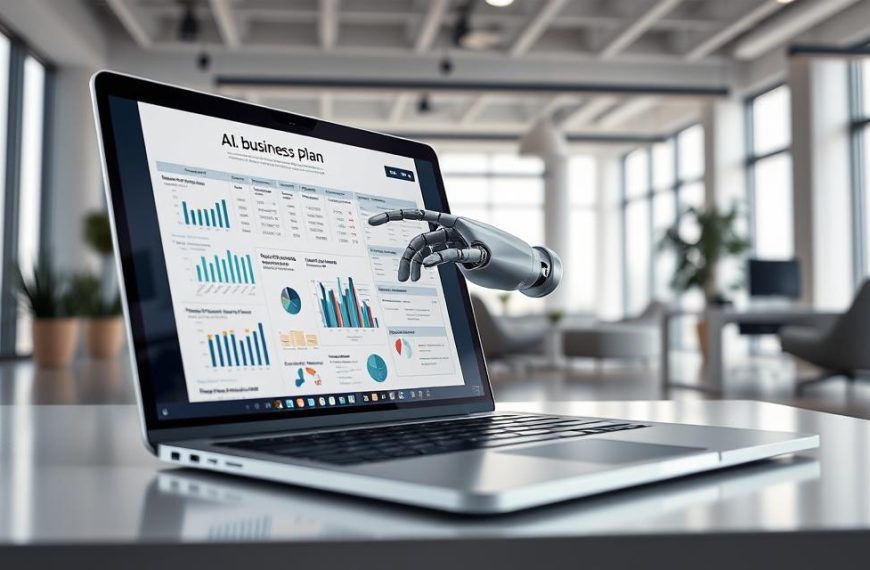The year 2018 marked a turning point in the adoption of artificial intelligence across various industries. Between 2015 and 2019, the use of AI in companies grew by an impressive 270%, rising from 10% to 37%. This period highlighted the rapid integration of AI into workflows, with 2018 serving as a foundational year for many organizations.
Key sectors such as healthcare, finance, and retail led the charge, leveraging AI to enhance efficiency and decision-making. Surveys from that time revealed that larger organizations, particularly those with revenues exceeding $500 million, were quicker to embrace these technologies.
2018 also saw the emergence of dedicated AI governance roles, reflecting the growing importance of ethical and strategic oversight. This shift underscored the need for structured approaches to AI integration, setting the stage for future advancements.
Introduction to AI Adoption in 2018
By 2018, artificial intelligence had become a cornerstone of innovation across industries. Its capabilities, including machine learning, natural language processing (NLP), and computer vision, were no longer experimental but integral to operational success. This shift marked a new era of automation and efficiency.
Companies began leveraging AI for diverse use cases, from customer service chatbots to advanced data analysis. For instance, Netflix generated $1 billion annually from its AI-driven recommendation system, showcasing the tangible benefits of these algorithms.
Early success stories highlighted AI’s potential. In healthcare, diagnostic systems achieved 93% accuracy, while retail personalization boosted sales by 30%. Manufacturing saw significant reductions in downtime through predictive maintenance.
However, technology in 2018 had its limitations. Workflow redesign was often necessary to integrate AI effectively. Additionally, concerns about job displacement due to automation began to surface, prompting research into workforce adaptation strategies.
Despite these challenges, 87% of companies viewed AI as a competitive differentiator. This widespread recognition underscored its growing importance in shaping the future of business operations.
How Many Businesses Implemented AI in 2018?
The adoption of artificial intelligence in 2018 showcased significant growth across global industries. Surveys revealed that 25-30% of organizations integrated AI into their operations, with key sectors leading the charge. This marked a transformative period for companies leveraging machine learning and advanced algorithms to enhance efficiency.
Global AI Adoption Rates
Regional variations in AI adoption were evident in 2018. North America led with a 32% adoption rate, driven by robust research and development investments. Asia-Pacific followed at 28%, with China and India spearheading growth. Europe trailed slightly at 24%, reflecting cautious but steady integration.
Larger organizations with over 500 employees were more likely to adopt AI, with a 41% adoption rate. In contrast, small and medium-sized enterprises (SMEs) lagged at 19%, often due to cost and talent barriers.
AI Adoption by Industry
Healthcare emerged as the frontrunner, with 38% of organizations using AI for diagnostic imaging and patient data analysis. Finance followed at 34%, leveraging AI for fraud detection and risk management. Retail adopted AI at a 28% rate, primarily for inventory management and personalized customer services.
Manufacturing also saw notable advancements, using AI for predictive maintenance and process optimization. Despite these successes, challenges like data infrastructure limitations and high implementation costs persisted.
A survey by MIT Sloan highlighted that 83% of executives prioritized AI in their strategies. This emphasis on machine learning and automation underscored its role as a competitive differentiator. Companies investing in R&D experienced higher adoption rates, showcasing the correlation between innovation and successful integration.
Key Drivers of AI Adoption in 2018
Economic and technological advancements in 2018 fueled widespread AI adoption. Organizations recognized the potential of machine learning and advanced analytics to transform their processes and drive revenue growth. Four primary factors accelerated this trend.
First, the explosion of data created a need for advanced analytics. Companies sought ways to extract actionable insights from vast datasets. Second, competitive pressure from early adopters pushed organizations to integrate AI to stay ahead. Third, cloud computing enabled scalable AI solutions, making it accessible to more businesses. Finally, proven ROI from pilot programs demonstrated the tangible benefits of AI adoption.
Cost-benefit analysis further supported AI adoption. The average implementation cost ranged from $250k to $1M, with a typical payback period of 12-18 months. Early adopters reported 40% productivity gains and a 60% reduction in customer service costs through AI-powered chatbots.
Regulatory changes also played a role. Tools for GDPR compliance emerged, enabling organizations to leverage AI while adhering to legal standards. McKinsey highlighted the success of CEO-led AI governance, emphasizing the importance of strategic oversight.
The rise of AI-as-a-Service platforms further reduced entry barriers. These platforms allowed smaller businesses to access AI capabilities without significant upfront investments. This democratization of technology accelerated adoption across industries.
| Factor | Impact |
|---|---|
| Data Explosion | Increased demand for advanced analytics |
| Competitive Pressure | Pushed organizations to adopt AI |
| Cloud Computing | Enabled scalable AI solutions |
| Proven ROI | Demonstrated tangible benefits |
Industries Leading AI Adoption in 2018
In 2018, artificial intelligence became a transformative force across multiple industries. Its applications ranged from improving diagnostic accuracy in healthcare to optimizing supply chains in manufacturing. This section explores how key sectors leveraged AI to drive innovation and efficiency.
AI in Healthcare
Healthcare emerged as a leader in AI adoption, with organizations using advanced algorithms to enhance patient care. For instance, IBM Watson Oncology provided treatment recommendations, improving decision-making for oncologists. Zebra Medical Vision utilized AI for imaging analysis, achieving 93% accuracy in cancer detection—surpassing human accuracy by 5%.
Patient risk prediction models also gained traction, enabling early intervention for chronic conditions. These use cases not only improved outcomes but also reduced costs, showcasing the tangible benefits of AI in healthcare.
AI in Finance
The finance sector embraced AI to streamline operations and enhance security. JPMorgan’s COiN platform reviewed contracts, saving 360,000 hours annually. Mastercard’s Decision Intelligence system prevented fraud, contributing to projected savings of $7.3 billion.
Robo-advisors managed $880 billion in assets, offering personalized investment strategies. These applications highlighted the role of AI in improving efficiency and reducing risks for financial organizations.
AI in Retail
Retailers leveraged AI to enhance customer experiences and optimize operations. Amazon Go introduced cashier-less stores, revolutionizing the shopping experience. Stitch Fix used AI stylists to drive $1.2 billion in revenue, while Walmart deployed shelf-scanning robots to improve inventory management.
These innovations demonstrated how AI could transform retail services, offering both convenience and profitability. The adoption of AI in retail underscored its potential to reshape traditional business models.
Across these industries, AI adoption in 2018 showcased the power of technology to drive innovation. From healthcare to finance and retail, organizations reaped significant benefits, setting the stage for future advancements.
Benefits of AI Adoption for Businesses in 2018
Artificial intelligence delivered measurable benefits to organizations in 2018, transforming operations and driving growth. Companies that embraced AI saw significant improvements in efficiency, revenue, and decision-making. These advancements were driven by the strategic use of machine learning and advanced analytics.
Operational benefits were among the most notable. AI enabled 60-70% faster data processing, allowing companies to make quicker, more informed decisions. Automated customer service systems operated 24/7, reducing response time and improving user satisfaction. Predictive maintenance reduced downtime by 35%, ensuring smoother workflows.
Financially, the impact was equally impressive. Early adopters reported an average revenue increase of 19%. Inventory costs dropped by 30-40%, thanks to AI-driven demand forecasting. Document processing became 53% cheaper, freeing up resources for other critical processes.
Strategically, AI provided a competitive edge. Predictive analytics enhanced decision-making, while personalization at scale, like Netflix’s recommendation system, improved customer engagement. These innovations helped organizations stand out in crowded markets.
Workforce benefits were also significant. Knowledge workers experienced a 40% productivity boost. Upskilling opportunities in AI management allowed employees to develop new skills, ensuring long-term adaptability. These advancements underscored the transformative power of AI in 2018.
Challenges Faced by Businesses Adopting AI in 2018
While 2018 was a pivotal year for AI adoption, many organizations faced significant hurdles. From financial barriers to operational complexities, integrating technology into existing systems proved challenging. These obstacles often slowed progress and required innovative solutions.
Cost of AI Implementation
One of the biggest barriers was the high cost of implementation. For enterprises, the average expense reached $1.2 million. Legacy system integration, data cleansing, and cloud infrastructure investments added to the financial burden. Many companies struggled to justify these upfront expenses, despite the long-term benefits.
Smaller organizations faced even greater challenges. Limited budgets often forced them to delay or abandon AI projects. Even when funds were available, the lack of in-house expertise made it difficult to manage the development process effectively.
AI Talent Shortage
The shortage of skilled professionals was another major issue. In the U.S. alone, over 300,000 AI positions remained unfilled. A survey revealed that 74% of companies reported a significant skills gap. The applicant-to-hire ratio for data scientists was 6:1, and the average salary for AI engineers reached $146,000.
This talent crunch forced organizations to rethink their strategies. Some partnered with AI vendors to access external expertise. Others invested in reskilling programs to train existing employees for new roles. These efforts helped bridge the gap but required time and resources.
Operational risks also posed challenges. Concerns about algorithmic bias, data privacy compliance, and model explainability added complexity. Nearly 47% of AI projects were abandoned due to these issues. Companies had to balance innovation with ethical and legal considerations.
Despite these hurdles, solutions emerged. Partnerships with AI vendors and reskilling programs enabled organizations to overcome obstacles. By addressing these challenges, companies paved the way for successful AI integration.
AI Adoption Trends in 2018
The landscape of technology in 2018 saw unprecedented shifts in AI adoption. Emerging tools and platforms redefined how organizations approached innovation, with a focus on scalability and efficiency. From chatbots to predictive maintenance, the years leading up to 2018 laid the groundwork for transformative processes.
Conversational AI took center stage, with 65% of companies implementing chatbots. These tools streamlined customer services, reducing response times and improving user satisfaction. Natural language processing (NLP) also gained traction, with the market growing 54% year-over-year to $8.2 billion. This growth highlighted the increasing reliance on software solutions for automation.
Computer vision emerged as a critical tool for quality control, enabling organizations to detect defects with unmatched precision. Predictive maintenance systems reduced downtime by 35%, ensuring smoother operations. AI-powered cybersecurity solutions protected sensitive content, while automated marketing tools generated personalized campaigns, boosting sales.
Strategic shifts marked the year, as companies moved from pilot programs to scaled implementations. The rise of MLOps practices ensured smoother deployment and management of AI models. Increased C-suite involvement in AI governance underscored its importance at the leadership level.
“The integration of AI into core operations was no longer optional—it was a necessity for staying competitive.”
Technological advancements further accelerated adoption. The release of TensorFlow 1.0 provided a robust framework for organizations to build and deploy models. Precursor models to GPT-2 showcased the potential of generative AI, while Edge AI deployments brought processing power closer to data sources.
The vendor landscape also evolved, with platforms like AWS SageMaker and Google AI Platform offering scalable solutions. These tools democratized access to AI, enabling even smaller organizations to leverage its benefits. The combination of emerging technologies and strategic shifts defined 2018 as a pivotal year for AI adoption.
| Trend | Impact |
|---|---|
| Conversational AI | Improved customer services |
| Computer Vision | Enhanced quality control |
| Predictive Maintenance | Reduced downtime |
| AI Cybersecurity | Protected sensitive data |
| Automated Marketing | Boosted sales |
Case Studies: Successful AI Implementations in 2018
Successful AI implementations in 2018 demonstrated the transformative power of technology across industries. From healthcare to manufacturing, organizations leveraged AI to achieve measurable outcomes, setting new benchmarks for efficiency and innovation.
In healthcare, the Mayo Clinic introduced an AI-powered sepsis detection system. This innovation reduced mortality rates by 25%, showcasing the potential of data-driven diagnostics. The system analyzed patient records in real-time, enabling early intervention and saving lives.
The finance sector also saw remarkable advancements. Capital One launched Eno, an AI-driven chatbot that gained over 2 million users in its first year. Eno provided personalized financial insights, improving customer service and engagement. American Express improved fraud detection by 40%, significantly reducing financial losses.
Retailers embraced AI to enhance operations and customer experiences. Lowe’s introduced LoweBot, an inventory assistant that restocked shelves 50% faster. This product streamlined workflows, ensuring shelves were always stocked and improving sales. Amazon Go revolutionized shopping with cashier-less stores, offering unparalleled convenience.
In manufacturing, Siemens implemented AI for quality control, achieving a 99.9% defect detection rate. This example highlighted how AI could enhance precision and reduce errors. DHL optimized delivery routes using AI, improving efficiency by 30% and reducing operational costs.
These case studies illustrate the diverse use of AI across sectors. They also highlight the challenges faced during implementation, such as high costs and talent shortages. Despite these hurdles, the results were transformative, paving the way for future advancements.
| Industry | Outcome |
|---|---|
| Healthcare | 25% mortality reduction |
| Finance | 40% fraud detection improvement |
| Retail | 50% faster restocking |
| Manufacturing | 99.9% defect detection |
These successes underscore the importance of strategic planning and investment in AI. As companies continue to innovate, the lessons learned in 2018 will remain invaluable for future work in AI integration.
The Future of AI Adoption Post-2018
The momentum of AI integration in 2018 set the stage for transformative advancements in the following years. By 2025, the AI market is projected to reach $390 billion, driven by rapid development and widespread adoption across industries. This growth reflects the increasing reliance on technology to solve complex challenges and enhance efficiency.
In the immediate post-2018 period, several trends emerged. Edge AI deployments grew by 300%, enabling real-time processing at the source of data. AutoML platforms gained mainstream acceptance, democratizing access to machine learning tools. Additionally, the expansion of AI ethics committees highlighted the importance of responsible adoption.
Long-term projections are even more ambitious. By 2030, 30% of the global workforce is expected to undergo transformation due to AI integration. The economic impact is estimated at $15 trillion, with Industry 4.0 integrating IoT and 5G technologies. These advancements will redefine the way organizations operate and compete.
However, emerging risks must be addressed. The misuse of deepfake technology poses significant threats to trust and security. Algorithmic accountability requirements are becoming stricter, necessitating transparent and fair AI systems. Global AI regulation frameworks are also being developed to ensure ethical development and deployment.
To support this growth, critical infrastructure investments are essential. The rollout of 5G networks will enhance connectivity, while quantum computing readiness will unlock new possibilities. Data democratization initiatives will ensure equitable access to AI tools, fostering innovation across diverse organizations.
- Immediate Predictions: Edge AI growth, AutoML adoption, AI ethics expansion.
- Long-Term Projections: Workforce transformation, $15T economic impact, Industry 4.0 integration.
- Emerging Risks: Deepfake misuse, algorithmic accountability, global regulation.
- Infrastructure Needs: 5G networks, quantum computing, data democratization.
The future of AI adoption post-2018 is marked by both opportunities and challenges. As organizations navigate this evolving landscape, strategic investments and ethical considerations will shape the way forward. The lessons learned in 2018 will continue to guide research and marketing efforts, ensuring sustainable and impactful change.
Conclusion
The transformative impact of AI in 2018 reshaped operational strategies across industries. With adoption rates reaching 25-30%, sectors like healthcare, finance, and retail led the charge. These organizations leveraged AI to enhance efficiency, reduce costs, and improve decision-making.
Critical success factors included executive sponsorship, workforce reskilling, and phased implementation. However, underestimating data requirements or neglecting change management often led to setbacks. Ethical considerations also played a vital role in ensuring responsible use of technology.
For successful integration, organizations should start with high-ROI use cases, build cross-functional teams, and establish clear KPIs. By 2025, AI is projected to become standard business infrastructure, driving innovation and competitiveness.















